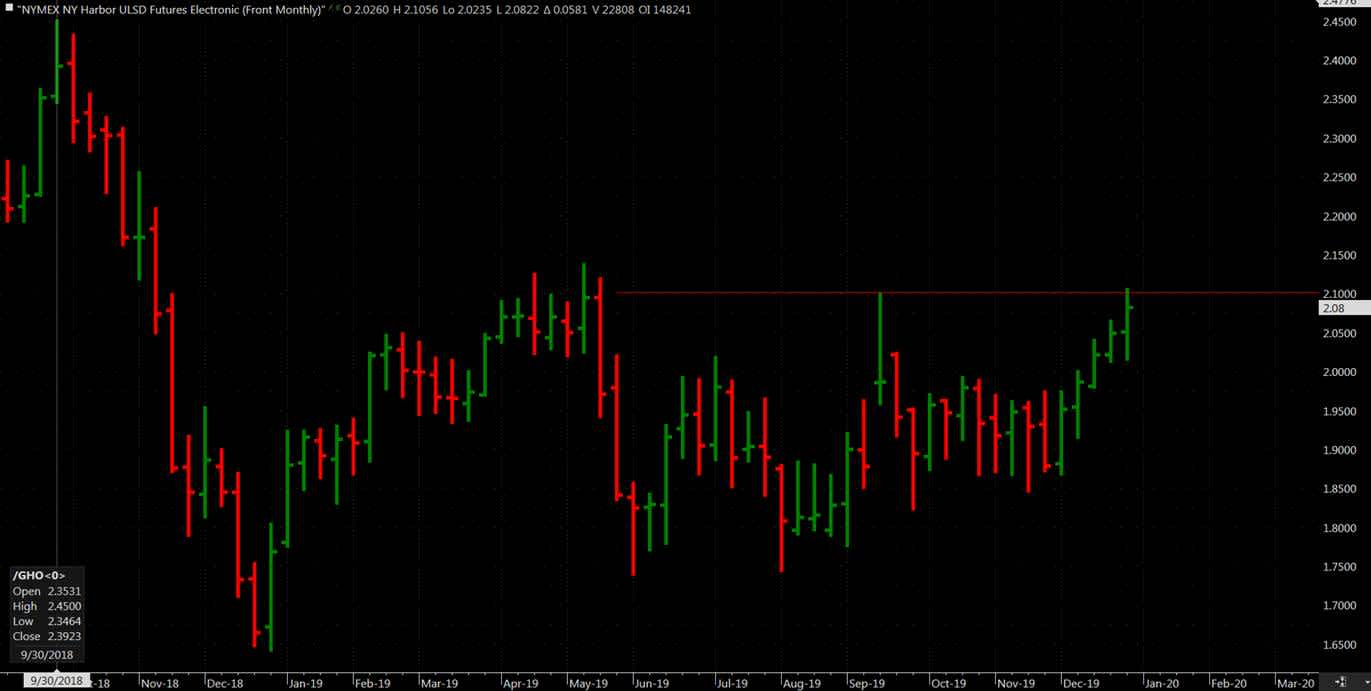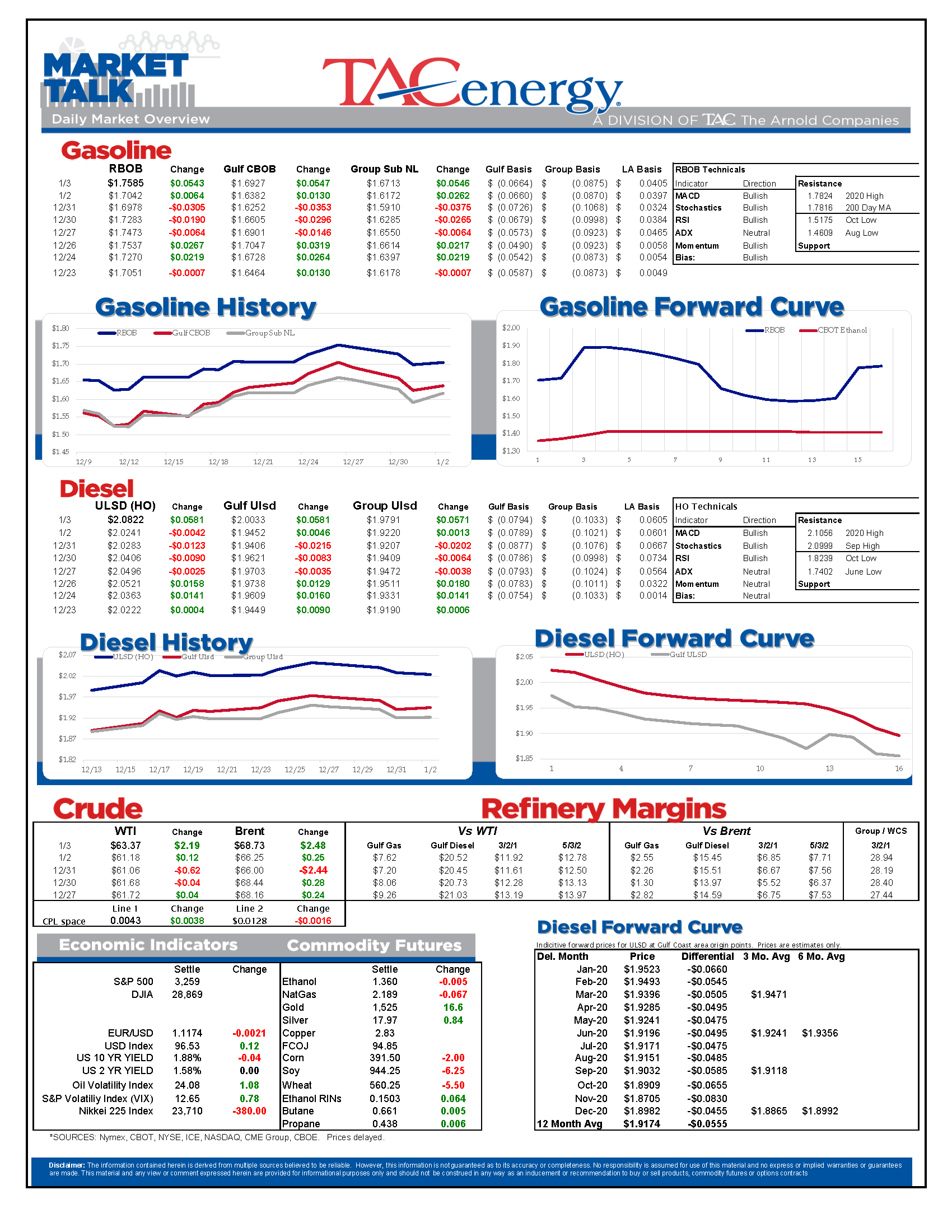Military Strikes Spur Energy Futures

U.S. military strikes in Iraq have spurred energy futures to their highest levels in more than seven months overnight, with most contracts up around four percent on the day. To be clear, there has been no immediate impact on oil supply, or even a direct threat on supplies in the region, but this situation is all about what might come next.
Is this the start of a larger military conflict between the U.S. and Iran that could threaten the Strait of Hormuz and 20 percent of the world’s oil supply? Or will this end up just another blip on the radar screen for an energy market like the attacks in Saudi Arabia or the sabotage to oil tankers last year due to ample global supplies and spare production capacity?
The reaction in stock markets to the news of the attacks is a good reminder that there could be a negative impact on fuel demand as well if this situation escalates.
The first test on the charts will be the high trades set in the wake of the Saudi Attacks last September, which were breached overnight by WTI, ULSD and RBOB futures, but have since pulled back below that level. As a reminder, within two weeks of the Saudi Attacks – which actually took more than five percent of global supply off the market temporarily – prices were lower than they had been prior.
RBOB futures are running into a cluster of resistance in the $1.77 range, which marks both the 200 day moving average on the continuation chart, and the high trades from September’s brief spike. For ULSD, the $2.10 range looks like the hurdle to clear if this rally is going to spark the next big move higher. If prices continue to push through the highs set in 2019, the next big targets on the charts are the 2018 high trades - roughly 30 cents above current values.
The fallout from the airstrikes in Iraq probably mean the market may shrug off the DOE’s weekly status report, which is due out at 11 a.m. EST due to the holiday this week.
Click here to download a PDF of today's TACenergy Market Talk.
Latest Posts
Week 17 - US DOE Inventory Recap
The Energy Complex Is Trading Modestly Lower So Far This Morning With WTI Crude Oil Futures Leading The Way
Energy Futures Are Drifting Quietly Higher This Morning
Refined Products Holding Close To Break Even While Oil Prices Are Losing Just Under 1%
Social Media
News & Views
View All
Week 17 - US DOE Inventory Recap

The Energy Complex Is Trading Modestly Lower So Far This Morning With WTI Crude Oil Futures Leading The Way
The energy complex is trading modestly lower so far this morning with WTI crude oil futures leading the way, exchanging hands $1.50 per barrel lower (-1.9%) than Tuesday’s settlement price. Gasoline and diesel futures are following suit, dropping .0390 and .0280 per gallon, respectively.
A surprise crude oil build (one that doesn’t include any changes to the SPR) as reported by the American Petroleum Institute late Tuesday is taking credit for the bearish trading seen this morning. The Institute estimated an increase in crude inventories of ~5 million barrels and drop in both refined product stocks of 1.5-2.2 million barrels for the week ending April 26. The Department of Energy’s official report is due out at it’s regular time (9:30 CDT) this morning.
The Senate Budget Committee is scheduled to hold a hearing at 9:00 AM EST this morning regarding a years-long probe into climate change messaging from big oil companies. Following a 3-year investigation, Senate and House Democrats released their final report yesterday alleging major oil companies have internally recognized the impacts of fossil fuels on the climate since as far back as the 1960s, while privately lobbying against climate legislation and publicly presenting a narrative that undermines a connection between the two. Whether this will have a tangible effect on policy or is just the latest announcement in an election-yeardeluge is yet to be seen.
Speaking of deluge, another drone attack was launched against Russian infrastructure earlier this morning, causing an explosion and subsequent fire at Rosneft’s Ryazan refinery. While likely a response to the five killed from Russian missile strikes in Odesa and Kharkiv, Kyiv has yet to officially claim responsibility for the attack that successfully struck state infrastructure just 130 miles from Moscow.
The crude oil bears are on a tear this past week, blowing past WTI’s 5 and 10 day moving averages on Monday and opening below it’s 50-day MA this morning. The $80 level is likely a key resistance level, below which the path is open for the American oil benchmark to drop to the $75 level in short order.
Click here to download a PDF of today's TACenergy Market Talk.

Energy Futures Are Drifting Quietly Higher This Morning
Energy futures are drifting quietly higher this morning as a new round of hostage negotiations between Israel and Hamas seem to show relative promise. It seems the market is focusing on the prospect of cooler heads prevailing, rather than the pervasive rocket/drone exchanges, the latest of which took place over Israel’s northern border.
A warmer-than-expected winter depressed diesel demand and, likewise, distillate refinery margins, which has dropped to its lowest level since the beginning of 2022. The ULSD forward curve has shifted into contango (carry) over the past month as traders seek to store their diesel inventories and hope for a pickup in demand, domestic or otherwise.
The DOE announced it had continued rebuilding it’s Strategic Petroleum Reserve this month, noting the addition of 2.3 million barrels of crude so far in April. Depending on what the private sector reported for last week, Wednesday’s DOE report may put current national crude oil inventories (include those of the SPR) above the year’s previous levels, something we haven’t seen since April of 2022, two months after Ukraine war began.
The latest in the Dangote Refinery Saga: Credit stall-out, rising oil prices, and currency exchange.
Click here to download a PDF of today's TACenergy Market Talk.

